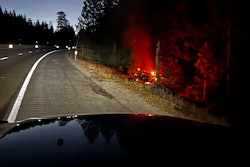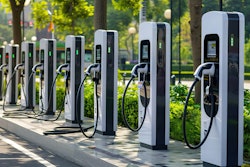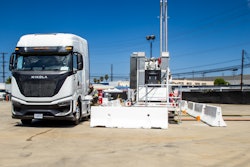As we think about the transition from internal combustion engines (ICEs) to battery electric vehicles (BEVs), we need to think about how we get power to the wheels for electric trucks and the overall vehicle implications.
In a previous article I talked about different types of motors in electric vehicles and the impact of magnets on sustainability.
How and where the motor is mounted, as well as whether a gearbox is needed, is an interesting topic in the BEV space. There are two different types of motor/gear box arrangements in BEVs. The first is referred to as Central mount and the other is an e-Axle.
 An illustration of the e-Axle (upper) and a Central Drive (lower)Source: https://www.danatm4.com/applications/commercial-vehicles/
An illustration of the e-Axle (upper) and a Central Drive (lower)Source: https://www.danatm4.com/applications/commercial-vehicles/
Central mount is typically located where the transmission is today for ICE vehicles. Some of its advantages are:
• “Conventional.” The vehicle architecture is similar to that of an ICE vehicle in that there is a heavy propulsion device (the motor) serving a purpose similar to that of an engine and transmission located in the same general area of the transmission. This is especially nice as we are in the Messy Middle where many vehicle manufacturers build BEVs one day and build ICE trucks the next day, all on the same line.
• Reliable Axle. It introduces no technology or reliability concerns at the axle. Similar axles are used between ICE vehicles and BEVs.
• Gear box elimination or simplification. In some cases, the motor is the only device at the central mount location. A major advantage of electric motors is that you get high torque at low motor speeds, and motors have a wide range of speed, so transmissions are eliminated. In some cases, a simple gear box is needed.
The alternative to the Central mount is the e-Axle. Here, the motor is mounted directly at the axle. Key advantages of the e-axle are:
• Space optimization. Since there is neither a transmission nor a driveline, and the motor is located at the axle, a lot of space is saved. This is advantageous for BEVs because batteries can be mounted in this location.
• Potential cost savings. While e-Axles might cost more now because of their newness and low volume, there is potential cost savings in the future. The driveline is eliminated and there can be savings in materials such as with the housing as the motor is integrated into the axle.
• Weight savings. e-Axles weigh less than the combination of a separate motor, driveline, and axle.
• Efficiency improvement. There are minor losses as energy and power are transferred from the gear box to the driveline to the axle on Central drive applications. Efficiency is important because every 1% improvement in overall vehicle efficiency, translates to a 1% higher range.
• Gear box. Transmissions are not needed and typically only one gear set is needed. The gear set is integrated into the axle, savings cost and space.
• Potential shortening of the wheelbase. Because space is saved, the wheelbase can be reduced, thus improving overall drivability.
Trucking is in an exciting time in the Messy Middle with numerous powertrain options. Within the BEV space, there are two major options for transferring power to the wheels. It is important that fleets understand these options, their advantages and disadvantages because overall cost and vehicle performance is affected.














